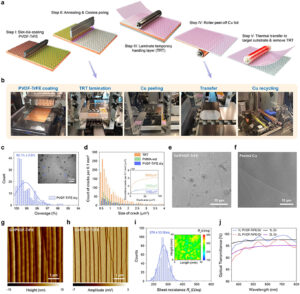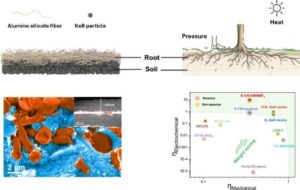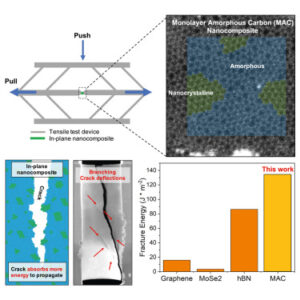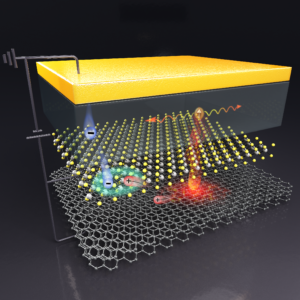Electric Field-tunable Ferromagnetism in a van der Waals Semiconductor Up to Room Temperature
Ferromagnetic semiconductors, coupling charge transport and magnetism via electrical means, show great promise for spin-based logic devices. Despite decades of efforts to achieve such co-functionality, maintaining ferromagnetic order at room temperature remains elusive. Here, we address this long-standing challenge by implanting dilute Co atoms into few-layer black phosphorus through atomically-thin boron nitride diffusion barrier. Our Co-doped black phosphorus-based devices exhibit ferromagnetism up to room temperature while preserving its high mobility and semiconducting characteristics. By incorporating ferromagnetic Co-doped black phosphorus into magnetic tunnel junction devices, we demonstrate a large tunnelling magnetoresistance that extends up to room temperature. This study presents a new approach to engineering ferromagnetic ordering in otherwise nonmagnetic materials, thereby expanding the repertoire and applications of magnetic semiconductors envisioned thus far.

For more information, see here.
Dendritic lithium growth on the current collector remains a major obstacle to developing anode-less batteries, arising from inhomogeneous lithium nucleation and uneven surface lithiophilicity. Existing approaches, such as metallic or carbonaceous interlayers, often fail to stabilize lithium deposition due to mechanical degradation or spatial variations in lithium affinity. Here, we demonstrate that a monolayer amorphous carbon (MAC) film—a single-atom-thick disordered sp2 network grown directly on copper—can fundamentally alter lithium nucleation behavior. The topological disorder of MAC produces a dense distribution of electron-rich sites that uniformly strengthen lithium binding. As a result, the MAC surface exhibits a lithium contact angle of 31 ± 5°, four times lower than that of graphene and nearly three times lower than that of bare copper, leading to homogeneous wetting and deposition. Electrochemical tests reveal a reduced nucleation overpotential of 28.9 mV at 0.5 mA cm−2. Density functional theory and scanning tunneling microscopy confirm that disorder-induced localization of states near the Fermi level enhances electronegativity and forms continuous lithium-binding sites. These findings establish intrinsic structural disorder, rather than chemical doping, as an effective route to designing uniformly lithiophilic current collectors for next-generation anode-less batteries.

For more details, see here.
Although chemical vapor deposition (CVD) produces meter-scale, high-quality graphene (Gr) on copper (Cu) foils, its practical integration is hampered by challenges in the transfer process. Conventional wet transfers are slow, produce chemical waste, and lack scalability, whereas existing dry transfer methods struggle with mechanical damage and residues due to strong Gr-Cu adhesion and the difficulty in precisely tuning interfacial forces. Here, a fully dry, industrially compatible transfer platform utilizing a ferroelectric poly(vinylidene-fluoride-trifluoroethylene) (P(VDF-TrFE)) film with electrostatically switchable adhesion, serving as both a mechanical support and a transfer layer, is demonstrated. Negative Corona poling of P(VDF-TrFE) induces p-type doping in graphene. Density Functional Theory calculations confirm that this simultaneously reduces Gr-Cu adhesion while increasing P(VDF-TrFE)-Gr adhesion, enabling clean, large-scale graphene delamination from Cu foils with >99% coverage. Subsequent thermal annealing above P(VDF-TrFE)’s Curie temperature (≈135 °C) depolarizes the film, neutralizing the interfacial charge for a clean release. The versatility of this method is shown for other two-dimensional (2D) materials, including molybdenum disulfide and hexagonal boron nitride. Crucially, the process has been validated on cm-scale samples using a fully automated system with a transfer time of <5 min, highlighting a viable path toward industrial-scale production of high-quality 2D material films.

For more details, see here.
Silicon has long been considered one of the most promising anode materials for high-performance lithium-ion batteries due to its high theoretical capacity. However, a significant challenge that restricts its practical application is the persistent issue of weak interfacial contact in the silicon anode, which leads to structural instability during lithiation/delithiation processes due to large volume expansion. In this work, we develop a dual welding encapsulation strategy by constructing Si–C chemical bonding between the silicon and conductive covering shells and establishing C–C interlayer bonding connections among the covering shells. By directly examining the interface of silicon-based composites, we identify the types of compounds and hybrid orbital structures from their spatial distribution using machine-learning-enhanced transmission electron microscopy analysis techniques. This dual welding mechanism not only enhances the mechanical strength of the protective carbon shell but also ensures sustained electrical connection between the core and shell through the Si–C bonds. The robust heterogeneous structure effectively mitigates interfacial instability within the silicon anode, suppressing volume expansion below 12% after 300 cycles. Thus, the full-cell with the composite anode and LiNi0.8Co0.1Mn0.1O2 cathode performs a high energy density of 576 Wh kg–1 and stable cycling, inspiring the construction of commercial silicon batteries.
![]()
For more details, please refer to this link.
Structural supercapacitors, potential game-changers for various applications such as aerospace, automotive, and construction industries, offer a combination of energy storage and load-bearing functionalities. Conventional approaches, however, have been hindered by a significant decrease in overall energy storage performance due to the inherent separation of energy storage components and structural reinforcement elements. In this study, we report reinforcement-free all-in-one structural supercapacitors that tailor the conventional trade-off problem between energy capacity and mechanical strength by ensuring that the essential energy storage components possess high mechanical properties. This dual-functional structure ensures that it volumetrically constitutes nearly 90% of the cells excluding the packaging. Simultaneously, by employing interlocking interfacial engineering, we optimize the functionalities of these components, enhancing the overall robustness and energy capacity of the device. Consequently, our structural supercapacitor demonstrates good structural integrity, as evidenced by its flexural modulus of 8.34 GPa. Moreover, our supercapacitor stands out in terms of energy storage capacity, boasting a volumetric energy density of 45 Wh/L. This achievement, outperforming the current state-of-the-art by a staggering tenfold, significantly enhances multifunctionality, a critical index for evaluating structural energy devices, reaching a 9.95 rating. This novel strategy provides insight for other structural energy storage devices with higher multifunctional efficiency.

This is an international collaborative work. For more details, please refer to this link.
The incorporation of a SiC interfacial layer has been recognized as an effective strategy to tackle the interface contact issue between Si and carbon, ensuring the structural integrity of Si-based anodes and thereby enhancing their cycling stability. However, its inherent low activity and poor conductivity pose a persistent challenge for maximizing capacity and facilitating ion and electron transport. Here, we present a thickness/content adjustable SiC interfacial layer in the Si–SiC–C heterostructure using a modified spark plasma sintering technique. The SiC layer, with a content of ∼10%, is discretely coated on the surface of the Si core, exerting minimal influence on capacity and ion/electron kinetics, while ensuring high electrode structural stability. Consequently, the Si-based anode exhibits a stable capacity of 582 mAh g−1 (0.1 A g−1) and good rate capability (324 mAh g−1 at 2 A g−1), while maintaining 80% capacity retention over 500 cycles with a low electrode swelling of 12.6%. More importantly, its capacity presents a continuous rising trend with the increase of the cycle number, suggesting a mechanism where the SiC interfacial layer gradually transforms into a Li-ion-rich phase. This transformation facilitates ion transport and reaction with Si, resulting in gradual capacity enhancement. Therefore, the reasonably thickness-regulated SiC interfacial layer holds promise for providing inspiration for the design of commercial Si-based anodes.
This work is with several international collaborators. For more details, please refer to this link.
The single-atom thickness of graphene holds great potential for device scaling, but its effectiveness as a thin metal-ion diffusion barrier in microelectronics and a corrosion barrier for plasmonic devices is compromised by weak van der Waals interactions with copper (Cu), leading to delamination issues. In contrast, monolayer amorphous carbon (MAC), a recently reported single-atom-thick carbon film with a disordered sp2 hybridized structure, demonstrates superior adhesion properties. This study reveals that MAC exhibits an adhesion energy of 85 J m−2 on Cu, which is 13 times greater than that of graphene. This exceptional adhesion is attributed to the formation of covalent-like Cu─C bonds while preserving its sp 2 structure, as evidenced by X-ray photoelectron spectroscopy (XPS) and near-edge X-ray absorption fine structure(NEXAFS) spectroscopy. Density functional theory (DFT) calculations further elucidate that the corrugated structure of MAC facilitates the hybridization of C 2p z orbitals with Cu 4s and 3dz 2 orbitals, promoting strong bonding. Theseinsights indicate that the amorphous structure of MAC significantly enhances adhesion while preserving its elemental composition, providing a pathway to improve the mechanical reliability and performance of two-dimensional(2D) materials on metal substrates in various technological applications.

This work is with several international collaborators. For more details, please refer to the link.
Despite the superior properties of two-dimensional (2D) materials, their low fracture toughness has limited practical applications. Our study demonstrates intrinsic toughening in monolayer amorphous carbon (MAC) nanocomposites predominantly composed of amorphous phases with small crystalline domains, showing significant enhancements in energy absorption during crack propagation. These improvements are quantitatively investigated through in situ SEM tensile testing and molecular dynamics (MD) simulations. This work not only unveils the toughening mechanisms but also introduces an intrinsic toughening strategy for 2D materials, enabling their use in fields requiring robust fracture resistance.

This work is with several international collaborators. For more details, please refer to the link.
Plasmonic tunnel junctions are a unique electroluminescent system in which light emission occurs via an interplay between tunnelling electrons and plasmonic fields instead of electron–hole recombination as in conventional light-emitting diodes. It was previously shown that placing luminescent molecules in the tunneling pathway of nanoscopic tunnel junctions results in peculiar upconversion electroluminescence where the energy of emitted photons exceeds that of excitation electrons. Here we report the observation of upconversion electroluminescence in macroscopic van der Waals plasmonic tunnel junctions comprising gold and few-layer graphene electrodes separated by a ~2-nm-thick hexagonal boron nitride tunnel barrier and a monolayer semiconductor. We find that the semiconductor ground exciton emission is triggered at excitation electron energies lower than the semiconductor optical gap. Interestingly, this upconversion is reached in devices operating at a low conductance (<10−6 S) and low power density regime (<102 W cm−2), defying explanation through existing proposed mechanisms. By examining the scaling relationship between plasmonic and excitonic emission intensities, we elucidate the role of inelastic electron tunnelling dipoles that induce optically forbidden transitions in the few-layer graphene electrode and ultrafast hot carrier transfer across the van der Waals interface.

This work is lead by Prof. Goki Eda’s group with contribution from Prof. Barbaros’ group. For more details, please refer to the link.
We report a new nanoporous amorphous carbon (NAC) structure that achieves both ultrahigh strength and high electrical conductivity, which are usually incompatible in porous materials. By using modified spark plasma sintering, we create three amorphous carbon phases with different atomic bonding configurations. The composite consists of an amorphous sp2-carbon matrix mixed with amorphous sp3-carbon and amorphous graphitic motif. NAC structure has isotropic electrical conductivity of up to 12,000 S/m, a Young’s modulus of up to ∼5 GPa, and Vickers hardness of over 900 MPa. These properties are superior to those of existing conductive nanoporous materials. Direct investigation of the multiscale structure of this material through transmission electron microscopy (TEM), electron energy loss spectroscopy (EELS), and machine learning-based electron tomography revealed that the origin of the remarkable material properties is the well-organized sp2/sp3 amorphous carbon phases with a core-shell-like architecture, where the sp3-rich carbon forms a resilient core surrounded by a conductive sp2-rich layer. Our research not only introduces novel material with exceptional properties, but also opens new opportunities for exploring amorphous structures and designing high-performance materials.

This breakthrough opens up new possibilities in energy storage, with implications for a wide range of industries. We are incredibly proud of our team’s dedication and hard work in making this achievement possible. For more details, please refer to the link. Let’s continue pushing boundaries and driving innovation together!

